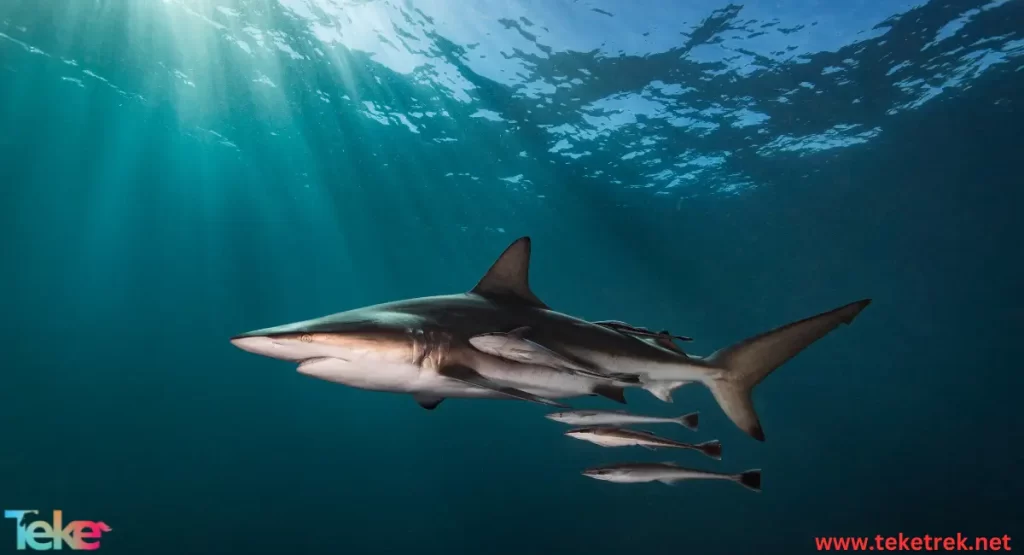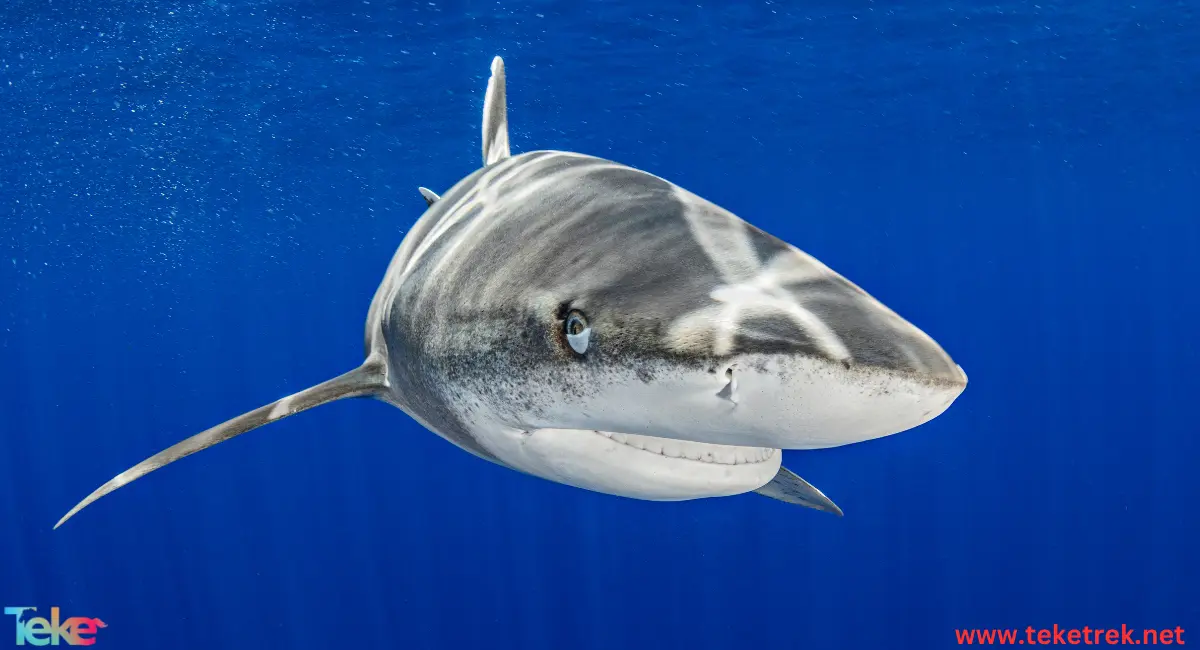God created the cosmic system in equality and order, and every creature created by God has a benefit, whether for humans or for the universe in general, as God created predators, pets, and all animals on planet Earth complementing each other in a harmonious food chain. Sharks are predatory marine creatures that live in oceans and large seas, and they are of great importance in the harmony of the ecosystem, as sharks feed on smaller fish, thus preventing the excessive reproduction of these species, which causes an imbalance in the marine ecosystem.
Sharks are among the most exciting creatures in the ocean due to their ferocity and attack on all marine creatures, and they are not peaceful. There are different types of sharks that differ in size and color, and they also have sharp and strong teeth and have an offensive force that is unmatched by any other marine animal. The shark also moves very quickly in the water, and in this comprehensive guide from teketrek، we will learn about everything related to sharks and their lifestyle.
Shark appearance
The shark has a robust cylindrical body, sometimes exceeding three meters in length and weighing up to 200 kilograms. It is characterised by a dynamic shape that helps it move at amazing speed in the water, as it is characterised by:
- The shark possesses a cartilaginous structure, making it more lightweight and flexible in the water.
- The shark’s head features five to seven small openings on the sides known as gill slits, responsible for facilitating water flow and obtaining oxygen.
- Sharks have distinctive fins, with most species having eight fins, including a dorsal fin, pectoral and pelvic fins, and unattached caudal fins.
- Shark colors vary between gray, brown, and blue, with color patterns differing among species.
- More than 400 known shark species exist, ranging from small ones like the dwarf lantern shark, with females not exceeding 18 cm in length and males around 15 cm, to the whale shark, which can reach lengths of 40 feet or more.
- Only 30 out of the 400 species are considered dangerous and pose a threat to humans. Among the most dangerous sharks in the world are four species: the great white shark, the bull shark, the tiger shark, and the oceanic whitetip shark.
- The lifespan of small shark species typically ranges from 15 to 20 years, while larger species can exceed 70 years in some cases. The average lifespan of a shark ranges between 20 to 50 years, depending on the species and environmental conditions.

Amazing characteristics
Sharks are considered among the fastest marine creatures, capable of moving at high speeds in the water. Speed varies among species, with some being among the fastest aquatic beings , in addition to that:
- Sharks exhibit exceptional body flexibility, moving with agility and speed despite their large size. The shark moves vertically due to its liver, which constitutes a quarter of its body volume and contains a substance less dense than seawater, allowing it to control buoyancy and dive easily.
- Shark reproduction methods vary, with some laying eggs and others giving birth to live young.
- Sharks are known for their continuous swimming, even during sleep, maintaining a flow of water through their gills to oxygenate their bodies while at rest. Unlike other fish, they lack air sacs to assist with breathing.
- Sharks possess special senses that allow them to detect electric fields emitted by living organisms in the water, aiding them in searching for prey and navigating their aquatic environment.
- Traditional medicine uses liver oil extracted from certain shark species to treat conditions such as arthritis and skin diseases.
- Some shark species can rapidly change the color of their skin, aiding in camouflage and self-defense.
- Sharks can survive despite sustaining injuries, thanks to an effective immune system and the rapid healing of wounds.
- Despite the stereotypical image of sharks, human attacks are rare and often result from misunderstandings. Humans are usually attacked when sharks are motivated by fear or self-defense.
- The shark’s ability to travel long distances is one of its remarkable features, with some species recording journeys covering thousands of miles without stopping.
Physical and anatomical characteristics of the shark
The shark belongs to vertebrates. It is a cartilaginous bony fish. It breathes through gills and has strong fins. Its structure consists of cartilage. It is cold-blooded and has different shapes and types. It is a huge fish in size and length, reaching a length of about 15 meters and a weight of about 20 kg. It has many colors, the most famous of which is gray. There are also other colors such as blue, brown and yellow. It has a strong sense of smell.
It has seven gill openings on each side, and sharks are famous for having a strong jaw lined with many teeth of different sizes, which fall out and grow back, their teeth are sharp and strong, and they have a pointed nose, and they have a strong sense of sight that allows them to see in low light.
Dealing with prey
Sharks possess an extraordinary sense of smell, using it to detect prey from kilometers away. Some can even sense trace amounts of blood in the water, in addition to that:
- Sharks have an amazing ability to assess the value of their prey through the initial bite. They can quickly determine the amount of fat they will gain from the catch. Sharks carefully choose their prey, preferring seals and sea lions for their high-fat content.
- Sharks rely on their sense of sight to locate prey and interact with the surrounding environment. They can see in low light conditions, enabling them to detect the faintest lights in the depths. Their skin contains cone-like structures, increasing their sensitivity to sounds and vibrations in the water.
- Shark teeth come in various sizes and shapes, including pointed cutting teeth for crushing shells and marine exoskeletons, long pointed teeth for easily slicing through fish bodies, and teeth specialized for attacking marine mammals such as whales, dolphins, and seals. Shark teeth act as razor-sharp blades and possess a hardness similar to that of diamonds.
Habitats and Locations of Sharks
Sharks inhabit both cold and warm oceans, roaming over long distances in search of prey. They are primarily found in the Atlantic and Pacific Oceans. Here are some notable seas and regions where sharks can be found:
1. North Sea and Atlantic Ocean:
- Some species inhabit the waters of the North Sea and the Atlantic Ocean, including polar sharks and other types.
2. Indian Ocean:
- Sharks, including some large species such as whale sharks and tiger sharks, inhabit the waters of the Indian Ocean.
3. Pacific Ocean:
- The Pacific Ocean hosts a diverse range of shark species, from coastal waters to deep-sea environments.
4. Caribbean Sea:
- The warm waters and coral reefs of the Caribbean Sea are home to many shark species.
5. Baltic Sea:
- Some sharks can be found in the waters of the Baltic Sea.
6. Southern Ocean:
- Certain sharks are present in the cold waters south of the Southern Ocean.
This wide range of shark habitats showcases the environmental diversity to which these marine creatures adapt in various oceans and seas.
Species of sharks
There is a wide variety of shark species that differ in their sizes, shapes, and habitats. Here are some well-known shark species:
1. Whale :
- Considered the largest shark and fish in the world, it is characterized by its massive size and dark blue color with distinctive spots and stripes on its body.
2. Bull :
- Known for its aggressiveness and danger, the bull shark has powerful jaws, an average size, and the ability to thrive in both saltwater and freshwater environments.
3. Tiger :
- Recognized for its dangerous pattern and immense strength, the tiger shark is among the most hazardous species to humans. Tiger lives in tropical ocean waters.
4. Great White :
- Among the most famous shark species, the great white shark is known for its sharp teeth and large, dark gray body. It is considered one of the most terrifying sharks for humans.
5. Hammerhead :
- Distinguished by its unique hammer-shaped head, the hammerhead shark is one of the most interesting species for researchers.
6. Goblin :
- Characterized by its long snout and large mouth that extends forward, the goblin shark is a deep-sea shark species.
7. Blue :
- Recognized by its slender body, long pectoral fins, and blue color, the blue shark inhabits deep waters in tropical and temperate oceans worldwide.
These are just some of the well-known shark species, and there are many other species living in various waters around the world.
Sharks reproduction
Shark reproduction processes vary among species and include several methods of sexual and asexual reproduction. Here is an overview of the shark reproduction process:
1. Sexual Reproduction:
- Sharks engage in sexual reproduction through mating between males and females. Females release eggs, and males externally fertilize them.
2. Asexual Reproduction:
- Some sharks species, such as bull sharks and whale sharks, represent asexual reproduction through viviparous birth. In this process, the offspring develop inside the mother and are born directly.
3. Egg-Laying:
- Some sharks species lay eggs in the aquatic environment. The eggs hatch to produce shark pups, and the offspring then grow independently.
Reproduction in Different Locations:
- The process and location of reproduction vary among shark species. Some species reproduce in coastal waters, while others reproduce in deep-sea environments.
- Shark pups obtain food available in their surrounding aquatic environment for nourishment.
Sharks food
- Sharks feed on a wide variety of fish and marine invertebrates.
- Small fish such as sardines, anchovies, herring, and mackerel are common prey for sharks.
- Sharks sometimes consume larger fish like tuna, mackerel, whales, and blacktip sharks.
- Sharks also feed on cephalopods such as octopus and squid, as well as crustaceans like shrimp and lobsters.
- Some small parasitic sharks species feed on algae and marine plants.
The difference between male and female sharks
- Males and females may exhibit differences in size and shape, with females being larger in some species like bull sharks, while males may be larger in other species.
- Social behavior can vary between males and females, with males often displaying more competitive behavior in certain species, while females may show a greater inclination towards maternal care.
- Reproductive organs differ between males and females, and there can be variations in the anatomical structure of reproductive organs.
- Colors and patterns may differ between males and females in some species as a means of distinction and to attract mates.
Shark behavior and lifestyle
Sharks have a lifestyle and behavior similar to humans, as some of them are calm sharks and others are predatory and quarrelsome, and here are the most important behaviors that sharks perform as follows:
- The shark prefers to stay alone, as it is not a social creature, and does not like to share its prey with other fish.
- It has strong senses, as the shark listens to and recognizes low, distant sound frequencies, and it also has a sense of smell that allows it to smell blood from meters away, in addition to sharp vision even in low light.
- Sharks communicate with others in many ways, such as hitting the water forcefully when angry, or arching their body as a form of threat.
- All sharks pose a danger to humans and should be cautious and not trusted because they are predatory, aggressive and swim very quickly.
- Sharks feed according to their type, as there is a type that feeds on tuna, mackerel, and mollusks, and another that feeds on plankton such as whale sharks and basking sharks.
- They hunt their prey by directly attacking it and grabbing it with their strong teeth and throwing it right and left until it is torn apart and then devouring it.
The importance of sharks in the ecosystem
Sharks play a very important role in preserving the marine ecosystem. Despite being predatory and aggressive towards humans, they do not target humans as an enemy, but rather consider them marine prey in front of them. Sharks feed on many types of fish and marine mammals such as seals and others, thus preventing the presence of many of these fish in the sea, which may cause the extinction of many types of small fish. Therefore, sharks create a balance in the marine food chain, and they are interested in devouring sick, old and slow fish in groups, which makes other fish more alert and strong.


Strange facts about sharks
Sharks are mysterious creatures and behave in strange ways. There are many facts about them, which can be mentioned as follows:
- Sharks are ancient animals, as they have lived for 400 million years, and it was said that Older than dinosaurs.
- The shark embryo has sharp fish that make it devour the rest of the embryos.
- Scientists have proven that sharks never sleep from birth until death.
- Their body does not contain air sacs, so they are constantly moving until they breathe.
- Scientists have proven that they take their stomach out to clean it and then put it back inside, and this process takes only a few seconds.
- The shark senses electricity through its organs called the ampulla of Lorenzini.
Threats facing sharks
Man is the first enemy of nature. Modern times, because sharks face many threats and dangers that threaten their lives and all marine creatures. Here are the most prominent threats and dangers as follows:
- Overfishing, as studies have shown that approximately 100 million sharks are caught annually, which makes them threatened with extinction, as sharks require a lot of time to reproduce, give birth, and reach maturity.
- Overfishing poses a 67% risk to all types of sharks.
- Natural changes in climate, as the extreme rise in temperature leads to a change in the water temperature, which poses a risk to some types of sharks. The extreme cold also makes fish that live in warm waters flee from it and do not find another place to live, and then they die.
- The waste thrown into the ocean hinders the movement of fish and may cause them to be poisoned.
Protection and conservation of sharks
- Sharks face threats due to illegal fishing and loss of marine habitats.
- International and local efforts are in place to protect sharks, including the establishment of marine reserves and regulation of the fishing industry.
FAQ
- How long do sharks live?
Sharks live for twenty to thirty years in the wild, but some may live longer than that.
- Do sharks lay eggs?
Shark reproductive patterns vary, some of them lays eggs and the other does not.
Finally
The shark is a remarkable marine creature with great diversity in species and appearance. It distinguishes itself by its strength and ability to adapt to diverse environments around the world, playing a crucial role in regulating the marine ecosystem. Despite its occasional negative reputation, it is essential to respect and preserve this wonderful organism, working towards protecting its natural habitats and maintaining its biological diversity.






